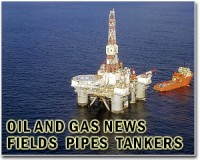 |
Paris (AFP) April 12, 2011 Shale gas, an energy source enjoying a boom in North America and Europe, carries a greater carbon footprint than oil, coal and conventional gas over at least a 20-year period, according to a study released on Tuesday. Scientists led by Robert Howarth from New York's Cornell University looked at greenhouse-gas emissions from the extraction of shale gas in the US, drawing on data from the oil and gas industry and from a federal auditing agency, the General Accountability Office (GAO). Shale gas holes up in a dense sedimentary rock which is fractured by large volumes of water and chemicals that are piped in horizontally under high pressure. After the fracturing, large amounts of water returns to the surface within a few days, along with significant amounts of methane, which comprises the bulk of the shale gas. The problem, though, is that methane is a potent greenhouse gas as well as as a fuel, and large amounts of it leak from shale-gas extraction, said the study. During the life cycle of an average shale-gas well, between 3.6 percent and 7.9 percent of the well's total production is emitted to the atmosphere as methane, it said. This comes through routine venting, equipment leaks and emissions that are included in the water flowback. These leaks are at least 30 percent more than -- and perhaps more than twice as great as -- those from conventional gas, although their emissions from routine production and downstream operations are the same, it said. Methane is more than 20 times more efficient than carbon dioxide (CO2), the principal greenhouse gas emitted by fossil fuels, for trapping solar heat. But it lingers in the air for only between nine and 15 years, whereas a molecule of CO2 stays around for a century or more. "The footprint for shale gas is greater than that for conventional gas or oil when viewed on any time horizon, but particularly so over 20 years," said the paper. "Compared to coal, the footprint of shale gas is at least 20 percent greater and perhaps more than twice as great on the 20-year horizon and is comparable when compared over 100 years." The study is published online in Climatic Change Letters, part of the Springer stable of journals. Major investments are being made in shale gas in the United States and in Europe. They are based in part on the goal of reducing geopolitical risk from imported conventional gas but also on the contention that shale is cleaner than oil and coal because it releases less CO2 for every unit of energy it provides. It thus can be a useful transitional energy towards a low-carbon economy, according to this argument. According to the US Department of Energy, total domestic production of natural gas will grow by 20 percent by 2035. Shale gas alone will increase its share of production from 16 percent in 2009 to 45 percent in 2035. "The large greenhouse gas footprint of shale gas undercuts the logic of its use as a bridging fuel over coming decades, if the goal is to reduce global warming," said Howarth. "The full footprint should be used in planning for alternative energy futures that adequately consider global climate change."
Share This Article With Planet Earth
Related Links Powering The World in the 21st Century at Energy-Daily.com
 Transocean claims record sea depth for oil drilling
Transocean claims record sea depth for oil drillingZurich (AFP) April 12, 2011 Offshore oil drilling group Transocean claimed Tuesday that it had a set a world record for deep water drilling at an ocean depth of 3,107 metres (10,194 feet) off the coast of India. The depth was achieved by the ultra-deepwater drillship Dhirubhai Deepwater KG2, surpassing the previous record of 10,011 feet, also set by Transocean in 2003 in the Gulf of Mexico, the group said in a statemen ... read more |
|
| The content herein, unless otherwise known to be public domain, are Copyright 1995-2010 - SpaceDaily. AFP and UPI Wire Stories are copyright Agence France-Presse and United Press International. ESA Portal Reports are copyright European Space Agency. All NASA sourced material is public domain. Additional copyrights may apply in whole or part to other bona fide parties. Advertising does not imply endorsement,agreement or approval of any opinions, statements or information provided by SpaceDaily on any Web page published or hosted by SpaceDaily. Privacy Statement |